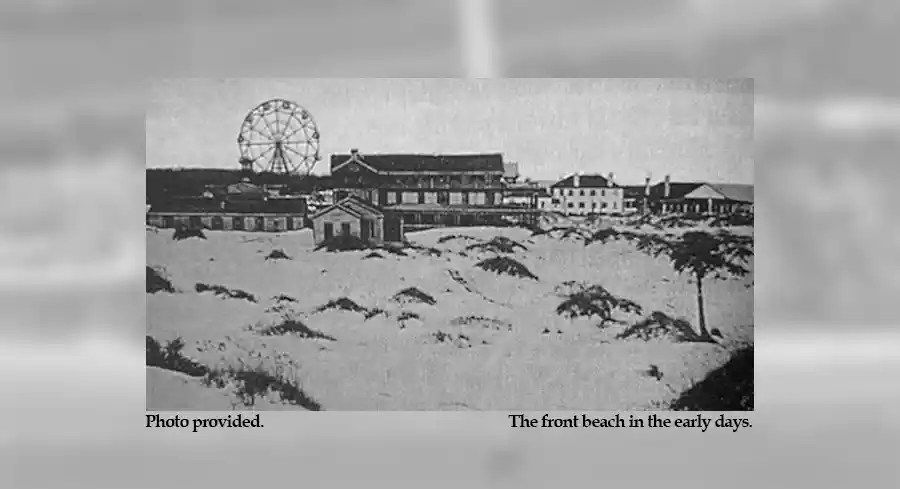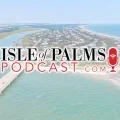
It’s no secret that there is a slice of heaven right here on Earth. Joseph S. Lawrence knew it too. One hundred years ago, the Lowcountry native envisioned creating a place for others to experience it for themselves. He even gave the island an enchanting name that was sure to lure them — the Isle of Palms.
“Coney Island of the South”
Lawrence had witnessed the financial success of beach resorts in the Northeast. And with the Lowcountry still struggling to find its economic niche in the decades following the Civil War, Lawrence and other investors had big plans to build the “Coney Island of the South.”
The greatest challenge would be transporting visitors to the island. With no bridges – and before widespread use of the automobile – the island had been known only to hunters. So, Lawrence established a ferry service from downtown Charleston to Mount Pleasant’s Old Village. From there, beachgoers boarded an electric trolley to Sullivan’s Island and then over to the Isle of Palms. Of course, that required the construction of two bridges crossing Cove Inlet and Breach Inlet. Once on the island, the trolley ran up what is now Charleston Boulevard and ended at his front beach resort which showcased a 400 square-foot dance pavilion, bath houses, a restaurant and the three-story Hotel Seashore. Adding to the fanfare were a giant 186-foot-tall Ferris wheel from the 1893 Chicago World’s Fair, a carousel from Coney Island and a mechanized steeplechase.
Lawrence’s vision was to create a haven for ordinary folks to leave their work-aday world behind and enjoy a brand of excitement most had never imagined. He was able to realize his dream in record time – just six months! On the first day, the local newspaper reported that 1,000 people had made the trip from downtown Charleston, and within the first month, 60,000 had visited.
J.C. Long’s Boulevard of Dreams
After Lawrence’s death, businessman James Sottile took over, and by 1914, he owned not just the resort but the entire island. Sottile built small bungalows as summer residences and rental cottages along Carolina Boulevard. Thirty years later, J.C. Long purchased 1,300 acres and added modest cinder block homes, establishing a community of affordable permanent residences – a dream Lawrence had also envisioned. They’d be considered small by today’s standards, but the kids weren’t going to be spending much time indoors anyway.
As a child, Ed Donnelly lived in one of those houses near Cameron Boulevard and 40th Avenue with his parents and his four siblings. “Our house was 900 square feet. There was no air conditioning, of course. But there was everything you can imagine to explore on that part of the island. Nobody built right on the beach back then, and there were lots of huge sand dunes – some 30 feet tall. And the woods – I remember we’d see herds of goats that swam over from Goat Island. And monster rattlesnakes– 8 feet long!”
A City on the Beach
With no city government on the island until mid-century, the Exchange Club was the driving force behind just about everything, including the establishment of a volunteer fire department funded by donations. In 1953, a referendum was held on whether to incorporate and provide tax-supported public services. The issue was controversial, but the vote passed 121-68. Walter (Buck) Chapman was elected the city’s first mayor.
Things were changing quickly. Two years earlier, an airstrip – with a runway made of oyster shells – had been constructed between 30th and 39th avenues. It operated until 1975. The Sand Dollar Campground on the wooded north end of the island boasted 100 campsites. Vacationers also flocked to the Isle of Palms Motel, located where the county park is now, near a 1,000-foot-long public fishing pier; both were destroyed by Hurricane Hugo in 1989.
Fanfare of Yesteryear
Island kids may have enjoyed exploring the woods, launching jon boats into the Intracoastal Waterway and crabbing at Breach Inlet, but Front Beach was a haven of fun for teens and young adults. During World War II, juke joints lined the block and even drew residents from across the Cooper for nighttime dancing. The Surf Deck, which stood where The Windjammer is now, was a popular hangout for decades, offering food, beer and sunbathing on the rooftop above the public bath house underneath. In the 1950s, the Playland Pavilion hosted bands like The Tams and The Drifters, who cranked out beach music. In the 1960s and ‘70s, the Old Side was the venue for local rock bands, and The Windjammer opened in 1972. Folks swarmed to several nearby hotspots to hear popular bands like Free Mountain Standstill and The Killer Whales, and Jimmy Buffet fans were occasionally treated to an impromptu gig by their favorite musician when he was in town.
The Citadel Beach Club, on the once-isolated north end of the island, was established 70 years ago and has served as a retreat for cadets and alumni ever since. And there was great excitement in 1972 when a resort, the Beach and Racquet Club, later Wild Dunes, was established by island resident Henry Finch. Tennis stars Billie Jean King and Andre Agassi were among the visiting pros who played there in the 1980s.
The Imperfect Storm
Hurricane Hugo brought a new look to the island. Nearly all the businesses along front beach succumbed to the storm, and 95 percent of the houses on the island were heavily damaged or destroyed. Rebuilding was not an option for many longtime homeowners who did not have flood insurance, forcing them to sell their empty lots. The new owners built larger homes, some of which became investment property. Ocean Boulevard was extended southward between 3rd Avenue and Breach Inlet and allowed for more beachfront houses.
A new bridge connecting the island directly with Mount Pleasant offered peace of mind to island residents who called for more efficiency in future evacuations. But the Isle of Palms Connector also made the island more accessible, opening the door for additional development.
Today, there are more than 4,000 residents on Isle of Palms and it’s still an idyllic place, just as its founding fathers intended it to be.
1897 – Lawrence and Long Island Development Company purchases island for $50,000
1898 – Resort opens on IOP’s Front Beach
1913 – First post office on IOP opens in pavilion
1914 – Businessman James Sottile becomes sole owner of IOP
1944 – Developer J.C. Long establishes the Beach Company and builds permanent residences
1946 – Surf Deck opens on Front Beach
1951 – Harold Wilson Memorial Airfield opens
1953 – Residents vote to incorporate the City of Isle of Palms
1958 – Red and White, first grocery store on the island, opens
1972 – Beach and Racquet Club opens
1989 – IOP devastated by Hurricane Hugo
1993 – IOP Connector opens
By Mary Coy




Leave a Reply